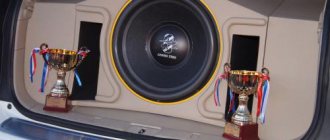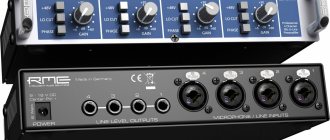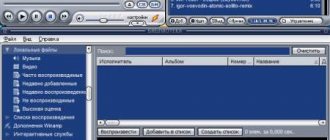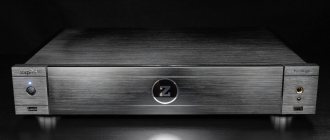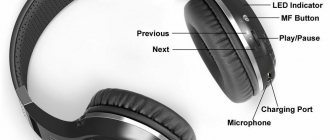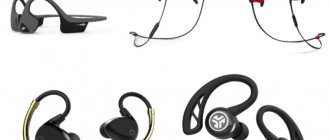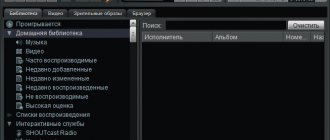It seems that the Koreans from theBit have already come down from the mountain and, like the bulls from the popular joke, have got down to business. Having started with the relatively simple but interesting OPUS#1 and continuing with the truly flagship “top” OPUS#2, they did not rest on their laurels and rolled out a model that was especially interesting because it goes against modern trends, calling it OPUS#3 . Naturally, this will be discussed.
While the industry is in full swing with AKM chips, periodically being distracted by new ESS models, theBit decided that this would be trivial, and remembered the wonderful and beloved PCM1792 chips from Burr-Brown. To this DAC they added a traditional well-customized Android, a high-quality, although not very powerful amplifier, and packaged it in an interesting case. They decided to position the new product somewhere between the two previous models and set a price of $900 (however, according to tradition, there are discounts), what interesting things will this player offer to customers?
Specifications
- Processor: 4-core ARM Cortex-A9 1.4GHz
- RAM: 1 GB DDR3
- DAC: Burr-Brown PCM1792A
- Frequency range: 20 Hz - 20 kHz (±0.026 dB), 10 Hz - 70 kHz (±0.3 dB) - both outputs
- Signal-to-noise ratio: 114 dB @ 1 kHz - both outputs
- Channel Separation: 130 dB @ 1 kHz - normal output, 135 dB @ 1 kHz - balanced
- Total harmonic distortion + noise: 0.0009% @ 1 kHz
- Output level (no load): 2.5Vrms - normal output, 3Vrms - balanced
- Output impedance: 2Ω - normal output, 1Ω - balanced
- Built-in memory: 64 GB
- Memory cards: MicroSD
- Battery: li-pol, 4000 mAh, 3.7V
- Operating time on one charge: ~8.5 hours
- Charging time: ~4 h
- Screen: touch, 4″ TFT IPS, 480 × 800
- Wireless interfaces: WiFi 802.11 b/g/n (2.4GHz), Bluetooth 4.0 (A2DP, AVRCP)
- Format support: WAV, FLAC, ALAC, AIFF, WMA, MP3, OGG, APE
- Supported resolution: up to 192 kHz/24 bit
- DSD support: native, up to DSD256, DFF and DSF supported
- Dimensions: 74 mm × 117 mm × 18 mm
- Weight: 220 g
Inside and outside
The Korean The Bit previously specialized exclusively in simple and inexpensive MP3 players, but decided to take the high-fi path and released the first Hi-Res player in its catalog called Opus #1. The device runs on Android OS, hidden under the audio player interface shell. You cannot install any games or applications on it - manufacturers have thrown out all the unnecessary stuff from standard Android, concentrating entirely on sound.
It’s not the camera’s matrix that’s noisy, but the plastic’s texture has a fine dot
And it is driven by a pair of CS4398 DACs from Cirrus Logic and a fully balanced amplifier. Other internals include 1GB of RAM, quad-core ARM Cortex-A9, and 32GB of internal storage. The memory is expandable using two slots for MicroSD cards, the maximum size of each is 200 GB. The player did not experience any problems with reading a wide variety of cards - it coped with both a long-standing 8 GB card and a brand new 128 GB card.
The player, of course, takes some time to scan large amounts of information, but not so much that it becomes annoying, and it doesn’t freeze when installing a new card. Opus #1 has no wireless interfaces - neither Wi-Fi nor Bluetooth, so to update the firmware it will have to be connected to a computer.
Externally, the player, like many similar devices, looks massive: a block with beveled edges and a 4-inch touch screen with a resolution of 800x480 slightly shifted to the left. The body is made of ABS plastic, similar in appearance to gray-black granite. Due to the plastic body, the player, despite its external massiveness, is unexpectedly light - it weighs 185 grams, and it lies comfortably in the hand, does not creak, does not play, or slip out.
A metal case would add weight to the device, and in cold weather it would probably not be so pleasant to communicate with the player, so I approve of the choice of such a finish. The back of the player is covered with tempered glass, under which the model name can be seen.
Every facet of the player is functional: on top there are audio connectors - balanced and 3.5 mm jack, as well as a power button, on the bottom - a microUSB connector. The buttons are located on the sides: on the left side there are volume control keys, on the right side there are three playback control buttons (previous track, pause/start, next track). This arrangement allows you to control the player blindly, but not through clothing: finding the buttons through thin jeans turned out to be problematic. In addition to the volume buttons, on the left side there are slots for memory cards, covered with a flap.
The buttons are small, but pressed without problems
The player interface is logical and simple. When turned on, the screen displays the album cover, song name, information about its quality and playback control buttons. In the upper left corner there is a “hamburger” button, when clicked you can get to a playlist or library. If you miss and poke at the cover, the player will show additional information about the composition.
The player is ready to display the music library in several ways: the entire music library in one heap, by albums, by artists, by genres, by folders, by playlists, or exclusively “Favorites”. The screen, like the player itself, responds quickly to pressing commands, so wandering through the music library does not provoke nervous breakdowns.
The Bit Opus #1 advanced settings menu
The classic Android “curtain” opens not notifications, but quick settings buttons. From this menu, you can use the slider to adjust the screen brightness, turn on the linear output, balanced output, equalizer, send the player to sleep, and also select the playback mode: repeat and/or shuffle. In the upper right corner, again standard for Android, there is a full settings gear where you can turn on sleep mode, select an output, adjust the balance, change the gain factor, and also play around with the equalizer. The equalizer is ten-band, you can save three custom options and choose from them. The effect is felt in the next second.
Two memory card slots are hidden under a flap. The plug holds tightly and does not open
The player has a 4,000 mAh battery, which, according to the manufacturer, will last 10 hours from outlet to outlet. The player lived approximately this long with continuous playback of FLAC 16 bit/44.1 kHz and 24 bit/96 kHz interspersed with MP3. But despite Android, the device is careful with power supply: it has a very successful sleep mode, which wastes virtually no energy, but wakes up the player with one short press of the power button. So, the player can lie for a week and be discharged by 30 percent, but at the same time be in combat readiness mode all the time.
Packaging and delivery
Going through different color options, theBit settled on noble gray. The packaging is traditional: a thick cardboard box in a paper “dust jacket”. Inside there is a player, protective films, instructions, a warranty card and a completely ordinary MicroUSB cable. The case will most likely not be included in the package, although there is still room for it in the box. I got the player with a cool branded case, which, most likely, was traditionally made by Dignis.
Design and management
If there was an award for the most memorable design, the creators of OPUS#3 would clearly be on the shortlist. The unusual, memorable texture of pyramids that decorates the back panel, the correct work with chamfers and bevels - all this creates an unusual appearance; the player clearly cannot be confused with anything else. Despite the fact that the back panel is made of metallized plastic, the main part of the player's chassis is aluminum, which is noticeable both in weight and in the noticeable strength of the assembly - nothing plays or creaks anywhere, everything is neatly fitted and assembled.
There are few controls. On the left side are the rewind and play/pause buttons. At the top are the outputs: regular 3.5 mm and balanced 2.5 mm. Traditionally, they can serve as a line output (theBit even has a clever wire that provides a true balanced connection). On the right side, flush with the rear panel, the volume control wheel was placed; it wobbles a little, but the adjustment does not cause any complaints - everything is clear, with well-defined clicks, without unnecessary triggers. The bottom side is occupied by a slot for MicroSD cards and a MicroUSB port, which traditionally serves for charging, accessing memory and working as a USB DAC. By the way, the built-in XMOS is responsible for the latter, so the DAC function here is as independent as possible from the processor. Through the same chip you can output the sound of the player’s built-in software, which should please fans of “absolute correctness.”
Most of the front panel is occupied by a touch screen, which is quite good by player standards. It remains visible in the sun (although it loses contrast), it has good viewing angles, and clicks are processed efficiently. I won’t even talk about resolution and color rendition - everything is fine with that too.
One of the strengths of theBit players is their firmware. Despite the use of Android 5.1.1, all the “insides” of the OS are carefully hidden, even installing third-party applications was previously impossible.
After loading, the user is immediately greeted with a playback screen, familiar from other players of the company, the main part of which is occupied by the cover of the current track. By tradition, 3 tracks from the Korean project Jazzotheque have already been loaded into the player’s memory (I’ve already become close to them). In the upper left corner there is a button to access the media library; as expected, there is browsing by tracks, artists, albums, folders and playlists. In general, navigation is made very simple and very convenient, everything is optimized for comfortable finger control.
If you swipe down from the top of the screen, a curtain of settings opens: brightness, Wi-Fi, BT, equalizer, and so on. Here you can click on the button with the gear icon to get to the main settings screen. Everything there is quite familiar from the Android OS, and, perhaps, only a couple of points require explanation, without telling us once again about the three-level gain switch, sleep timer and playback without pauses. In the same settings menu, the USB-DAC mode is turned on (hint: to exit it, you need to click on the circle in the center of the screen).
The first interesting menu item is
Output - DSP Mode .
Here you can choose which sound output mode will be used by the player: through the I2S interface of the DAC or through the XMOS chip, which, as you remember, is also on board. Anyone can try both options and choose the one they like best. Another interesting menu item is Streaming . theBit effectively solved the problem of supporting streaming. If you remember, in the review of OPUS#2 I wrote that it was not clear why Wi-Fi was needed in the phone, because its only use was updating the firmware. Now the company’s firmware has the ability to add its own software, and they even installed two programs out of the box. The first is the Spotify client: everything in it is exactly as you expect. The second is a player very similar to the main one, but with support for accessing files via DLNA/UPnP. Moreover, the player can, if necessary, itself act as a storage/renderer, this allows you to easily build any wireless audio transmission schemes. I think that in the future the network player will replace the regular one, since there is probably no real need to have both programs on the device.
If you wish, you can additionally install your programs into the player; to do this, you need to download the APK, put it on the player in the Downloads folder and in the Streaming menu, click on the plus button. A list of available packages will open and you can select the one you need to install.
I will also note that the firmware for OPUS#2 was recently updated - similar features were added there.
In general, the firmware is stable, reliable, no freezes or defects were found in it. The operating time is close to the declared one and is 8 hours 15 minutes (standard test in FLAC 44.1/16 bit, MEE Audio P1 as a load, mid gain, volume at 70), charging time is 4 hours 10 minutes. The player has a deep sleep mode, so the device uses battery sparingly. A small drawback is that when playing with the screen turned off, this same power saving mode disables the hardware playback control buttons after a while, so the player must first be “woke up” by pressing the power button.
Review of Opus #3. When the third one is not superfluous
While China remains the factory of the whole world, and divides it into its supporters and haters, sound production is developing not only there, but also in Korea, which is distant to us and close to China. Of course, the first thing that comes to mind is Astell&Kern, but the Korean land is not only rich in them. One of the companies that has recently, but quite firmly staked out a place in the market, is theBit. Today they are no longer beginners and have earned a reputation as a company that knows how to make sound. And while Opus #4 flashes in the photos from the exhibitions, we’ll talk about the three. No consistency in the positioning of the devices has yet been identified, so 1 remains the company’s most affordable players, Opus #2 is considered the top (now there are very good discounts on it), and 3 is positioned as the upper-middle segment. The player comes in a dark blue box (finally not black!), hidden under a gray dust jacket with the model name on the front and technical specifications on the back. Having removed the lid of the box without any frills, vertically upward, we find the player itself on a support made of foam material. Among the useful accessories, it is worth noting the case - it fits very tightly on the device, covers the memory card slot on the bottom edge and leaves access to the port for charging and other communications with the outside world. The top edge of the case is open, so access to the standard 3.5 and balanced 2.5 outputs is also maintained. Closer to the right side there is an oblong button to turn on/lock the player; it protrudes noticeably from the body, has a good movement and, of course, does not play. A volume control wheel is placed on the right side of the device. It is placed in a very original way, reminiscent of that in some Astell&Kern models - i.e. lying on the back of the device and recessed into it. Personally, I like this method, especially since the stroke is moderately tight, the encoder is of very high quality, the clicks are pleasantly felt and setting the required volume is not an effort. It is marked on the screen with horizontal lines and numbers. There are almost no accidental triggers in the pocket, either with or without the cover. Buttons for blind control of playback have been moved to the left side - everything is just fine with them, except that the case covers them completely and it’s not so easy to find the right one through it. Otherwise, everything is more than excellent. Stylish metallic (mostly) silver block with chopped lines, the edges and part of the back panel are covered with geometric corrugation and slightly contribute to a better grip, but overall I would prefer the case - it is dark blue in color, apparently leather, fits tightly around the body and adds almost no size to the device. The side edges and the back are covered with silver-colored plastic panels recessed into the body with the same pyramidal texture (partially on the back). The assembly is good and the player feels like a complete device, although when used without a case, the sharp corners dig into the palm a little. Under the hood of the device they decided to place the now unfashionable PCM 1792A, seasoning this with good wiring and a fairly “quiet” (albeit average in power - 3Vrms on the balanced and 2.5 on the unbalanced output) amplifier, once again proving that the main thing is not the DAC, but its implementation in a specific device. The output impedance was overlooked, and the engineers decided that 1 balanced and 2 unbalanced outputs would be sufficient to match most portable headphones. The operating system is customized Android 5.1.1 with all that it implies - the interface is simple, logical, and responsive. Scanning the music library is quite fast; an original feature is that in the absence of covers, the player displays its selection of music-themed pictures. In general, no difficulties or obvious problems were found; using the player is simple and pleasant. A 4000 mA battery allows the player to work for about 8-9 hours, and the device takes about 4 to charge. As for the sound of the device, it definitely deserves attention. The player was made detailed, musical, with a good dark background, slightly dark, energetic sound and with a fairly correct structure of the stage. Low frequencies have good control and detail. The number of lowest frequencies is balanced, the hits are full-bodied and massive, and good variability allows you to play soft, barely noticeable introductions. Of course, the texture is also very good. With a general shift in balance to a slightly more macro-detailed, holistic and warm sound, the bass copes well with fast, heavy genres and there is no lack of detail. The mids have good resolution, they slightly accentuate the transfer of emotions and bring the soloist to the fore, making the recording sound impressive and beautiful. The forcing of emotions is quite neat, the player is far from turning everything into blind rage - on the contrary, it adds a little drama, like on a theater stage. So the solo instruments sound very expressive and emotional. In this case, a slight emphasis is obtained on the separation of plans, but good interaction between them is maintained, the instrument part does not appear out of nowhere and does not disappear without a trace. The high-frequency range is literally a little sharp, the length is not record-breaking, but to be honest, you need to look for recordings where this can be heard. The attacks are swift, defined and fast, and the decays are of sufficient length and, thanks to good resolution, do not get confused with each other. The stage is larger than average in width and depth, its correct proportions do not create the feeling of a squeezed corridor with crowded performers, nor an open field with instruments scattered across it, the localization of instruments is generally correct, and the stage is built from the middle to the edges, thus slightly highlighting the solo instrument and creating effective separation. All this is complemented by a good dynamic range, allowing you to fully enjoy the emotions embedded in the recording. The player cannot be called very picky about the quality of the recording - it tends to highlight the main thing in it - emotions, and convey them to the benefit of the listener. But, of course, a good player needs good records; he still doesn’t know how to resurrect the dead and work miracles. Despite the non-zero output impedance, I also had no problems with the selection of headphones; it sang well with both dynamic and reinforcement models. Of course, it may not open up tight full-size models, but as for portable headphones, everything is fine here.
Sound
The following headphones were used to listen to the device: iBasso IT03, Meze 99 Classics, Audio Zenith PMx2, Noble Kaiser Encore, Campfire Audio Andromeda, 64 Audio U12, HUM Pristine and others.
theBit is well aware that releasing several players with a similar sound and a fairly close price is not a particularly smart idea, so they decided to make OPUS#3 more tasteful compared to their flagship number two and, in fact, they were right. The Third Opus offers exactly what many value in the presentation of players: a slightly warm, energetic sound with accentuated emotions.
The bass is very, very slightly accentuated to create a slight darkening effect in the presentation. The bite is slightly reduced to give the sound more massiveness, but this is done very carefully, without pronounced distortions. The player reproduces textures well and separates low-frequency instruments. Sub-bass is present, but it is slightly reduced in quantity so as not to create unnecessary turbidity in the low frequencies.
Mid frequencies are transparent and slightly emphasized in terms of emotionality. Sometimes it seems that the player specifically highlights the vocals and adds emotion to the vocalists. With OPUS#3 it’s very pleasant to listen to classic bluesmen, all your favorite jazz singers, raucous rockers - it’s as if they lose 20 years and return to the times of maturity and maximum flowering. Naturally, the player is good in terms of resolution, but at the same time it does not go into sharpness and does not try to pull out all the micronuances from the recording; on the contrary, it can sometimes even hide some flaws. The imaginary stage is very wide, but without additional bloat, the depth is also slightly more than average, but not as record-breaking as the width. Shot separation is very good, especially due to the emphasis on vocals.
HF is generally good, quite detailed and with high-quality attenuation. Sometimes OPUS goes overboard with attacks, and because of this the highs sound a little harsher than intended, but the right selection of recordings and headphones allows you to never encounter this. This problem is also less pronounced in the XMOS DSP mode, however, the difference is small and can be attributed to a placebo effect.
Well, where would we be without a few comparisons?
theBit OPUS#1 . The first OPUS captivates with its love for inflating an imaginary scene, which gives an effective sound, but not always natural, plus it is distinguished by a neutral and slightly dry presentation. The Troika doesn't try to exaggerate the volume, conveying it as it is, and overall the player sounds a little darker and more energetic. Plus, OPUS#3 has a darker “background” and due to this, individual sounds are better defined.
theBit OPUS#2 . The main task of the flagship is to play without embellishment, but not boringly, and the “second” copes with this well. It emphasizes emotions less (although it conveys what is in the recording flawlessly), it has deeper bass and better separation into layers, and it also has more detailed and natural high-frequency processing. Although in fact the difference between #2 and #3 is small (less than between #3 and #1), there is a feeling of a “step forward”.
iBasso DX200 . In some ways the opposite of OPUS#3 - neutral, completely uncolored with maximum resolution and detail. The main problem of the iBasso player is its wild pickiness about recording quality. The opus is more tolerant in this regard, and its presentation is more emotional and slightly less resolution.
Fiio X7+AM2 . In general, the presentation of these players can, with a slight stretch, be called similar, but in fact there is a noticeable difference in the placement of accents - the player from Fiio is a little less sharp in the high frequencies and a little simpler in the midrange.
Fiio X5-3 . Not exactly a competitor to OPUS#3, but since the model has been popular lately, I can’t ignore it. The newcomer from Fiio is just an even greater bias in the direction that Opus only indicated - even more warmth in the sound, more relaxed treble, and everything else that is necessary to create a “comfortable” presentation.
Compatibility
According to the company's tradition, the player is not made to be the most powerful, however, this is a very reasonable approach that allows you to save battery life and not hear unnecessary noise. The power of OPUS#3 is quite enough for any IEM and most full-size headphones, and there is no noise even in sensitive models like the CA Andromeda. Of all my huge arsenal, the LAM-7 from Ambient Acoustics and Noble Kaiser Encore performed best with this player. Among the more affordable models, hybrids from Dunu and the interesting new Periodic Audio Beryllium are traditionally good. With OPUS#3 you should avoid headphones with accentuated high frequencies and high frequencies.
The player is quite universal in genre, although its energetic presentation is especially good on blues, classic rock, and instrumental music. He is moderately critical of the quality of the recording, somewhere around 7 points on a 10-point scale, the main thing is that everything in the recording is normal in the high-frequency range.
By tradition, several tracks as an example of
The Beatles - Being for the Benefit of Mr. Kite! If you didn’t already know, a commemorative reissue of “Sergeant Pepper” has been released, dedicated to the 50th anniversary of the album. The entire record was actually re-mixed from scratch, and I can say that the result turned out excellent: it allows us to once again be convinced that few musicians in the modern history of mankind can even compare with The Beatles. By the way, true fans will appreciate the 6-disc edition, which includes a variety of studio takes that allow you to understand the process of the birth of the album. Naturally, with a good player in the person of OPUS#3, these recordings sound even better, and the added emotions are very appropriate.
Marillion - White Paper . Long gone are the days when Marillion gave a rebirth to the prog-rock genre, and the debate over whether a band with Hogarth can even be considered a Marillion has died down. The lineup, assembled in 1989, proved its worth and showed stability that was surprising for bands of this genre. There were ups along the way of the team like “Anoraknophobia” and downfalls like “Afraid of Sunlight”, but FEAR turned out so well that it can immediately go on the list of the best works of the group. It has everything: wonderful melodies, emotional, despite Hogarth’s age, vocals, an interesting idea... All that remains is to add OPUS#3 and good headphones and enjoy the return to the times of Misplaced Childhood and Clutching at Straws, noting, however, the fact that the group is still she became calmer, like most of her fans.
James Brown - I'll Go Crazy (from Live at the Apollo) . The Godfather of Soul provides a master class in live performance and crowd interaction, and it's no wonder the album is considered one of the best live recordings of all time. Be sure to listen to it, even if you can’t stand live performances, in this case it’s just an example of how to work with the public, and with OPUS#3 the immersion in the atmosphere of 1962 is even more complete. I never cease to wonder how it was possible to make such a high-quality recording with such primitive technology, but the fact remains that even now rare live albums can boast such a level of both technology and material.
Opus #1 on the topic OPUS #3. Or a short essay about a little-known Korean player.
The Korean company theBit is little known in our country. Even among those who try to follow the topic of portable sound. Somehow they failed to make a serious appearance in Russia.
Nevertheless, the products of this brand deserve very, very serious attention. For those who are seriously interested in the topic of portable audio, it is obvious that in recent years manufacturers have focused more on adding bells and whistles, making bodies smaller, increasing operating time, supporting streaming services and similar entertainment. And the sound was left, perhaps, with a beautiful description in advertising brochures.
In general, the world of overclocked portable audio, in just a few years, has gone all the way from mediocre-sounding but cheap MP3 players, past expensive and good players, and very quickly returned again to the topic of mediocre MP3 players, but at the price of expensive good players. True, with the addition of beautiful logos like “HiRes”, or the promise of 32-bit acoustic nirvana and other marketing delights.
However, the topic of the prospects for the development of portable audio is a separate article, let’s return to the player.
And in this sense, OPUS is pleased that the basis of this product is sound. Although all other components are not a weak link. It has a good design, the menu is quite logical and easy to understand. There is little that is superfluous, the necessary is not thrown away. In general, if you are looking for a device that sounds, and not a conventional sub-telephone player with “pumped up sound”, aimed mainly at displaying CD covers, of which there are simply a monstrously large number, you should take a close look at this device.
To be honest, during all the time I have been working on the topic of portable audio, I have forgotten how to write sheets of meaningless texts, which are often mistakenly called “reviews”. Therefore, I will quickly mention important points regarding the player and simply advise you to listen to this device in person if you have such an opportunity and are looking for decent sound.
What is its charm? Well, as for me, first of all, it uses a really good chip as a converter - PCM1792. Of course, in itself it doesn’t mean much, but the basis of the sound is still in it. This chip (IMHO) is still the best delta-sigma converter on the market, easily putting any popular youngster like Saber and AKM to shame.
OPUS #3 is a very discreet device with good tonal balance. Picky listeners will note, perhaps, a slight dominance of low-frequency sounds. What gives the sound a touch of massiveness, density, power, mass, if you like. It should be noted that the sound does not break into muttering, hum, or smear. Low frequencies are dense, percussive, with good pump. I am sure that most listeners will include this feature as one of the advantages of the model. A common problem with modern players is weakness, blurring of low frequencies, lack of energy in blows and pops. I can say with confidence that the player does not have this problem.
Excellent mids should also be praised. Again, if I’m being picky, then in aggressive melodies they could be a little more “evil”, but... that’s if I’m being too picky. Otherwise, they are clean, well readable, transparent, without distortion. It’s not even clear what else to write about them? It is difficult to describe a sound that does not have a “wow” effect, but has real quality.
Particularly noteworthy are the high frequencies. In fact, they are what make it a very unusual player in the player market. HF is generally a disease of modern portable audio. Not every player, even the highest price, can boast of purity, distinct sounds, smoothness, lack of scattering and distortion at high frequencies. This player can. Moreover, the complexity of the material practically does not matter. Even bottomhole metal will not become a noticeable problem. Again, particularly picky and (well, very experienced) listeners can say that in the HF there is a feeling that they are, as it were, “normalized”. Those. there are not many gradations in volume. But - what is important - there are no gross distortions in them. There is no typical problem that most “tops” suffer from - reducing all high-frequency information to a uniform sand-like rustling and/or sharp sparkling “crystal” sounds (which many for some reason consider “detailing”). In general, if you consider that this is portable audio and not stationary, then there are no complaints about the high frequencies from the word “at all”.
In general, if you are looking for good sound, then you should definitely include this player in the list of those devices that you should familiarize yourself with before purchasing.
Thanks to the patefon.ru store for the opportunity to get acquainted with this player.

